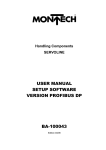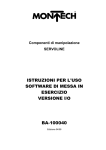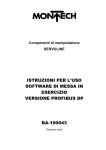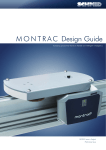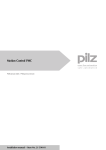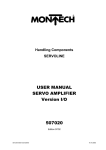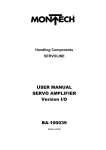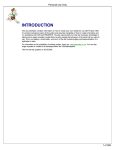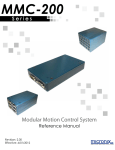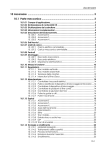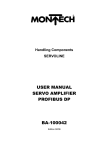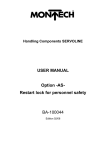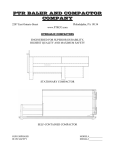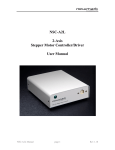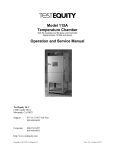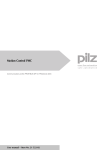Download user manual setup software version i/o ba-100040
Transcript
® Handling Components SERVOLINE USER MANUAL SETUP SOFTWARE VERSION I/O BA-100040 Edition 04/08 Setup software (Version I/O) Version 04/08 Change index Editions issued so far: Edition Comments 02/01 07/01 07/01 07/01 First edition, valid from software version 2.00 Title page, new: Edition 07/01 Header new: Edition 07/01 Page 2-22 Chapter 2.5.1. Additional text under "Outside pos.1 and pos. 2“ Page 2-24 Chapter 2.6.1. Plug X11B/ terminal 4 new: PosReg 4 (Next-InPos) Plug X11B/ terminal 5 new: FError negated Plug X11B/ terminal 10 new: PosReg 3, High-aktive Page 2-25 Chapter 2.6.1.2. 4, PosReg 4 (Next-InPos) additional text 5, new: Ferror negated Page 2-26 Chapter 2.6.1.2. New 8...10, PosReg 1...3 Chapter 2.4.4.1 Motion task is ABS or REL... Chapter 2.6.1.2-4 If "Outside pos. 1 and pos. 2" is active, then the function Next-InPos on X11B/4 is inactive Chapter 2.15.1 Changes and new software limit switches values Chapter 2.15.2 Changes and new values Chapter 2.16.4 New default values Chapter 2.18.2 SSI code function is binary or GRAY New article number New Vista 07/01 07/01 07/01 07/02 02/06 04/08 Order number (English version) 507002 507002 507002 BA-100040 BA-100040 A I Setup software (Version I/O) 1. Version 04/08 GENERAL ........................................................................................................ 1—1 1.1 Introduction _____________________________________________________________ 1—1 1.2 “Use as directed”_________________________________________________________ 1—2 1.3 Software description ______________________________________________________ 1—2 1.4 Operating systems _______________________________________________________ 1—3 1.4.1 Microsoft WINDOWS Vista, XP, 2000, NT, ME, 98, 95................................................................... 1—3 1.4.2 DOS, OS2, WINDOWS 3.xx .............................................................................................................. 1—3 1.5 Hardware requirements____________________________________________________ 1—3 1.6 Installation under Microsoft WINDOWS Vista, XP, 2000, NT, ME, 98, 95 ____________ 1—4 1.7 Software operation _______________________________________________________ 1—5 1.7.1 General ................................................................................................................................................ 1—5 1.7.2 Function keys ...................................................................................................................................... 1—5 1.8 Software structure ________________________________________________________ 1—6 1.9 Screen layout ____________________________________________________________ 1—7 2. PARAMETERS AND FUNCTIONS .................................................................. 2—9 2.1 Screen page «Communication» _____________________________________________ 2—9 2.2 Software structure (open area)_____________________________________________ 2—10 2.3 Screen page «Linear axis» ________________________________________________ 2—11 2.4 Screen page «Position data» ______________________________________________ 2—13 2.4.1 Field «Status messages».................................................................................................................... 2—13 2.4.2 Table «Motion tasks»........................................................................................................................ 2—14 2.4.3 Screen page «Next motion task» ....................................................................................................... 2—15 2.4.4 Field «Setup» .................................................................................................................................... 2—17 2.4.5 Field «Motion task» .......................................................................................................................... 2—20 2.4.6 Message............................................................................................................................................. 2—20 2.4.7 Field «Reference traverse»................................................................................................................ 2—21 2.5 Screen page «Threshold- / cam function»____________________________________ 2—22 2.5.1 Position registers ............................................................................................................................... 2—22 2.6 Screen page “I/O digital X11“ ______________________________________________ 2—24 2.6.1 Digital inputs and outputs, expansion card X11A/B ......................................................................... 2—24 2.7 Screen page «digital I/O X3»_______________________________________________ 2—26 2.7.1 Digital inputs DIGITAL-IN1 / DIGITAL-IN2 / PSTOP / NSTOP ................................................... 2—27 2.7.2 Digital outputs DIGITAL-OUT1 / DIGITAL-OUT2........................................................................ 2—30 2.8 Screen page «Status» ____________________________________________________ 2—32 2.8.1 Error messages .................................................................................................................................. 2—33 2.8.2 Warnings ........................................................................................................................................... 2—34 2.9 Screen page «Actual values» ______________________________________________ 2—35 2.10 Screen page «Info» ______________________________________________________ 2—36 2.11 Software structure (password-protected area) ________________________________ 2—37 2.12 Enter password _________________________________________________________ 2—38 2.13 Screen page «Linear axis» (password-protected area) _________________________ 2—39 2.14 Screen page «Change password» __________________________________________ 2—39 2.15 Screen page «Limit values» _______________________________________________ 2—40 2.15.1 Software limit switches 1 and 2 ........................................................................................................ 2—40 2.15.2 Limit values....................................................................................................................................... 2—41 II Setup software (Version I/O) Version 04/08 2.16 Screen page «Settings» __________________________________________________ 2—42 2.16.1 Field bus............................................................................................................................................ 2—42 2.16.2 InPosition behaviour ......................................................................................................................... 2—43 2.16.3 Operation mode................................................................................................................................. 2—44 2.16.4 Loading default values ...................................................................................................................... 2—44 2.17 Screen page «Electrical gearing»___________________________________________ 2—45 2.18 Screen page «Encoder emulation» _________________________________________ 2—46 2.18.1 ROD .................................................................................................................................................. 2—47 2.18.2 SSI..................................................................................................................................................... 2—48 2.19 3. Screen page «Feedback» _________________________________________________ 2—49 APPENDIX ..................................................................................................... 3—50 3.1 Abbreviations and acronyms ______________________________________________ 3—50 3.2 Glossary _______________________________________________________________ 3—51 3.3 Index __________________________________________________________________ 3—52 III Setup Software (Version I/O) 1. General 1.1 Introduction Version 04/08 This manual explains the installation and handling of the setup software for the digital servo amplifier (Version I/O). The information is broadly arranged as follows: • • • Chapter 1: General information / installation / screen layout / operation Chapter 2: Parameter description Chapter 3: Glossary, index This manual forms part of the complete documentation of the SERVOLINE products. The complete documentation consists of the following documents: • • • • Description Connection to automation systems (version I/O) Setup software (version I/O) Servo amplifier (version I/O) Mechanical design of the SERVOLINE products Ref. No BA-100038 BA-100040 BA-100039 miscellaneous The documentation is available in the following language versions: German, English, French, Italian, Spanish and Swedish. • Please read this documentation before commencing with setup. Incorrect handling of the servo amplifier can lead to personal injury or material damage and render the warranty void. It is vital that you keep to the technical data and information on connection requirements. • A basic knowledge of the operating system WINDOWS and of the use of a personal computer is assumed. Strictly observe all instructions relating to safety, installation and setup. • Only properly qualified personnel are permitted to perform activities such as installation, setup and maintenance. Properly qualified persons are those who are familiar with the assembly, installation, setup and operation of the product, and who have the appropriate qualifications for their job. The qualified personnel must know and observe the following standards or guidelines: IEC 364 and CENELEC HD 384 or DIN VDE 0100 IEC report 664 or DIN VDE 0110 National accident prevention regulations or VBG4 1—1 Setup Software (Version I/O) 1.2 Version 04/08 “Use as directed” The setup software is intended to be used for altering or storing the operational parameters of the servo amplifier of the SERVOLINE products. The servo amplifier that is connected is commissioned by means of the software - whereby the drive can be directly controlled by the setup and service functions. Due to the characteristic nature of a PC, these functions do not provide operational safety without further measures. A PC program might unexpectedly be disturbed or stopped, so that in the event of a malfunction, any movements that have already been initiated can no longer be stopped from the PC. The equipment manufacturer is obliged to prepare a hazard analysis of the equipment, and is also responsible for functional, mechanical and personal safety aspects in relation to the machine. This applies especially to the initiation of movements by way of functions in the setup software. Sets of data that are stored on data media are not safe from unintended alteration by third parties. After a set of data has been loaded, all parameters must always be checked before the servo amplifier is enabled. Servo amplifiers are components that are built into electrical equipment or machinery; they must only be operated as integral components of such equipment. The BTB contact must be wired into the safety loop of the system. The safety loop as well as the stop and emergency stop functions must comply with the requirements of EN60204, EN292 and VDI2853. Before operating the servo axes, all work is to be carried out as specified in the operator manuals of the servo amplifier and the Servoline axes. Strictly observe all safety regulations. 1.3 • Assembly, installation, wiring and final check have been carried out according to the operator manual for the servo amplifier. • Assembly, installation, wiring and final check have been carried out according to the operator manual for the servo axes. Software description The servo amplifier has to be adapted to the conditions of the application (target position, acceleration, speed etc.). Such parameterisation is not carried out on the amplifier itself but on a PC by means of the setup software. The PC is connected (in series) to the servo amplifier via a null-modem cable. The setup software establishes communication between the PC and the servo amplifier. With very little effort, you can alter parameters and instantly see the effect on the drive, since there is a permanent (online) connection to the amplifier. Important process values / actual values are simultaneously read out from the amplifier and displayed on screen. You can store (archive) sets of data on a data carrier and load them again. The data set currently in use can be printed. 1—2 Setup Software (Version I/O) 1.4 Operating systems 1.4.1 Microsoft WINDOWS Vista, XP, 2000, NT, ME, 98, 95 Version 04/08 The setup software runs under Microsoft WINDOWS Vista, XP, 2000, NT, ME, 98, 95. 1.4.2 DOS, OS2, WINDOWS 3.xx The setup software will not run under DOS, OS2 or Windows 3.xx. Emergency operation is possible with ASCII terminal emulation (no user interface). Interface settings: 9600 baud, 8 bit, 1 stop bit, no parity, no handshake. 1.5 Hardware requirements Minimum specifications of the PC: Processor: Operating system: Graphics card: Resolution: Drives: Main memory: Interface: Intel Pentium or higher Microsoft WINDOWS Vista, XP, 2000, NT, ME, 98, 95 Windows-compatible, colour 800 x 600 pixels minimum CD drive Hard disk (5 MB free space) 8 MB minimum One free serial interface (COM1: or COM2:) The interface must not be used by any other software (driver or similar). 1—3 Setup Software (Version I/O) 1.6 Version 04/08 Installation under Microsoft WINDOWS Vista, XP, 2000, NT, ME, 98, 95 Connect or disconnect the interface only if all the supply voltages (amplifier and PC) have been switched off. On the CD you will find an installation program with the name SETUP.EXE which makes it easier for you to install the setup software on your PC. Connection to the serial interface of the PC: Connect the interface cable to a serial interface of the PC (COM1 or COM2) and to the PC interface (X6) of the servo amplifier. Switch-on: Switch the PC and the monitor on. When the boot phase has finished, the Windows user interface appears on screen. Installation: Click on START (taskbar), then on Run. Enter the program call: a:\setup.exe (where “a” is the correct drive letter). Confirm by pressing OK and follow the instructions. Setting up the graphics card (font size) Click on the desktop with the right mouse button. The dialog window “Properties” appears. Select the file card “Settings”. Set the font size to “Small fonts”. Follow the instructions provided by the system. 1—4 Setup Software (Version I/O) 1.7 Software operation 1.7.1 General Version 04/08 The setup software is basically used in the same way as other Windows programs. Note that after any parameter alteration on a screen page, you must first click on APPLY so that the parameter is transferred to the RAM of the servo amplifier. (Pressing the “Return” key after altering a parameter value also has the effect of transferring the parameter set to the RAM of the servo amplifier). Only then should you leave the page. If a reset of the servo amplifier is necessary to activate a function, this is recognised by the software which will carry out a reset after a software confirmation request. The currently valid data set must be saved in the EEPROM of the servo amplifier in order to be permanently stored. Therefore execute the Save Data to EEPROM function on the “Linear axis” page (! chapter 2.3) before the servo amplifier switches off or before processing of the data set has been completed. 1.7.2 Function keys Function key Function Comment F1 Help Contextual help, in preparation F2 Not used Not used F3 Not used Not used F4 Not used Not used F5 Not used Not used F6 Teach-in (F6) Teach-in function for: • F7 Teach-in (F7) Positioning data " motion task position s_cmd [µm] Teach-in function for: • Threshold function/cam function " positions 1 and 2 • Limit values " Software limit switch positions 1 and 2 F8 Not used Not used F9 STOP (Off) Emergency stop F10 Not used Not used F11 Not used Not used F12 Disable Disable the output stage via software Shift + F12 Enable Enable the output stage via software 1—5 Setup Software (Version I/O) 1.8 Version 04/08 Software structure MONTECH Setup software Open area Password-protected area Motion task data Digital I/Os Setup mode Limit values Basic settings Open area The open area of the software provides the user of the linear axis with the option of changing any of the relevant operation-specific data while meeting the limit values defined by the equipment manufacturer. This can be the case when setting up the equipment for a different product. The user of the equipment is thus able to carry out the required changes. The following changes may be made: • • • • • Opening and saving data on a hard disk/diskette. Only data of the respective type of linear axis can be loaded. Motion task data. Input values within the limit values specified in the pasword-protected area. Setup operation. Threshold function and cam function. Function of the digital I/Os. Password-protected area In the password-protected area of the software the equipment manufacturer can define equipmentspecific limit values. The operator of the equipment is thus unable either not to reach, or to exceed, the limit values. The following additional changes can be made: • • • • • Erasure of the EEPROM. Loading default data or special solutions from hard disk/diskette. Limit values: maximum traversing rate, acceleration, emergency stop ramp, following errror and I2tmessage. Software limit switch positions. Operation mode (master-slave or position mode), encoder emulation, electrical gearing, feedback system, in-position behaviour. 1—6 Setup Software (Version I/O) 1.9 Version 04/08 Screen layout Title bar Symbold bar Menu bar Communication Status bar Title bar The program name, the station address as well as the name of the currently valid data set (amplifier) are displayed in the title bar. Toolbar Typical Windows-style buttons provide direct access to individual functions. Status bar Shows current information on data communication. 1—7 Setup Software (Version I/O) Version 04/08 Menubar FILE A parameter or motion task data set is read from the data medium (hard disk, diskette). Only data of the same type of linear axis can be opened. The current data set is closed and not saved. Close Saves the current parameter and/or motion task data set to a data carrier Save (hard disk, diskette) while keeping the file name, if the data set already has a name. If the data set has yet not been named, you will be prompted to enter a name and storage location. Saves the current parameter and/or motion task data set to a data carrier Save as (hard disk, diskette). You will be prompted to enter a name and storage location. The current data set will be printed out. You can choose whether to send Print the print data to the system printer or save it to a file. Print preview / Print setup Use these functions in the same way as for any other Windows software. Terminates the program. Exit COMMUNICATION Open COM1/COM2 Offline Deactivate interfaces If one of these interfaces (ports) is available for communication with a servo amplifier, i.e. if it is not being used by any other equipment or drivers, then the text label appears in black and can be selected. Select this interface and use it for connecting to the servo amplifier. In preparation This deactivates access to the setup software from interfaces COM1 and COM2. (chapter 2.1) Multi drive EDIT Undo / Select line / Cut / Copy / Paste / Delete Use these functions in the same way as for any other Windows software. Toolbar / Status bar Switch to show or hide the toolbar (top) or the status bar (bottom) on the screen. Cascade / Tile vertically / Arrange icons Use these functions in the same way as for any other Windows software. STOP (F9) ? Stops any motion task functions that are currently active. Device information VIEW WINDOW SERVICE 1—8 Setup Software (Version I/O) 2. Version 04/08 Parameters and functions This chapter describes all the parameters that can be accessed via the setup software. 2.1 Screen page «Communication» COM1, COM2 If one of these interfaces (ports) is available for communication with a servo amplifier, i.e. if it is not being used by other equipment or drivers, then the text label appears in full black and can be selected. Use this interface for connecting to the servo amplifier. • • • • Select the interface which you are using. The status bar shows the status of communication with the servo amplifier. If communication is working properly, the parameters stored in the servo amplifier are read into the PC. A dialog window keeps you up to date. Offline In preparation. Deactivate interfaces This deactivates access to the setup software from interfaces COM1 and COM2. 2—9 Setup Software (Version I/O) 2.2 Version 04/08 Software structure (open area) The open area of the software provides the user of the linear axis with the option of changing any of the relevant operation-specific data while meeting the limit values defined by the equipment manufacturer. This can be the case when setting up the equipment for a different product. The user of the equipment is thus able to carry out the required changes. The following changes may be made: • • • • • Opening and saving data on a hard disk/diskette. Only data of the respective type of linear axis can be loaded. Motion task data. Input values within the limit values specified in the pasword-protected area. Setup operation. Threshold function and cam function. Function of the digital I/Os. Communication COM1/2; offline Linear axis Main window Actual values Current drive data INFO Enter password for protected area Positioning data Motion tasks Reference traverse Set-up operation Default values I/O digital X11 Signal state Store data Parameters and/or motion tasks I/O digital X3 Configurable Signal state Open file Parameters and/or motion tasks Status Reset Errors Warnings EEPROM RAM --> EEPROM Next motion task Threshold/cam function 4 registers Store in STOP Stop all motion tasks, jog mode etc. 2—10 Setup Software (Version I/O) 2.3 Version 04/08 Screen page «Linear axis» Click with the left mouse button on a button on the screen page to call up the respective function or screen page. Saves current parameters to a data carrier (hard disk, diskette). It is possible to save control parameters and motion task parameters in separate files. Loads a parameter file or motion task file from a data carrier (hard disk, diskette). Only data records of the respective linear axis can be loaded. Opens the screen page «Actual values» to display the actual drive status. ( ! chapter 2.9) Non-volatile storage of the currently valid parameter set, in the EEPROM of the servo amplifier. In this way, all the parameter changes made since the last switch-on / reset of the servo amplifier, can be permanently saved. Stops (cancels) motion functions (motion task, homing). Opens the screen page «Instrument info» to display the hardware and software versions. ( ! chapter 2.10) 2—11 Setup Software (Version I/O) Version 04/08 Opens the screen page «Position data» ( ! chapter 2.4) Opens the screen page “Threshold-/cam function” ( ! chapter 2.5) Opens the screen page “I/O digital X11” ( ! chapter 2.6 Opens the screen page “I/O digital X3” ( ! chapter 2.7) Opens the screen page “Status” ( ! chapter 2.8) If a fault is present, the text of the button changes. • • • Status = OK Error Warning Shows the enable status of the amplifier • • • • • Software Disable/Enable: Enable No Hardware Enable No Software Enable No Enable Offline Disables or enables the servo amplifier via the software. This signal is logically “And”-linked inside the servo amplifier with the hardware enable (terminal X3/15). Disabling and enabling can also be undertaken via the function key F12 or Shift+F12. This function does not ensure personnel safety. To disable the servo amplifier so as to ensure personnel safety, the enable signal (terminal X3/15) must be removed and the line (mains) power must be switched off. End processing: Ends processing of the current parameter set. If you have made any changes, you will be asked if you want to save the data. 2—12 Setup Software (Version I/O) Version 04/08 2.4 Screen page «Position data» 2.4.1 Field «Status messages» Upper field: Shows the enable status of the amplifier • • • • • Lower field: Enable No Hardware Enable No Software Enable No Enable Offline Shows the error status of the amplifier • • • Status = OK Error Warning 2—13 Setup Software (Version I/O) 2.4.2 Version 04/08 Table «Motion tasks» For each of the positioning tasks, you will need to specify a motion task. These motion tasks can be selected via a motion task number, and are stored in the servo amplifier. The motion task No. 0 is a direct order and can be described or executed only via field bus systems. Motion task number 1...180 0, 181...255 Stored in Precondition for storing Comments EEPROM Output stage disabled Permanently stored RAM None Volatile storage Entries in the table can only be made after activating the Enter key. To complete the entry, press the Enter key again. The data are stored in the EEPROM only after you click on the Accept button. The following functions are available for editing motion tasks: Functions Select line Cut Copy Paste Delete Keyboard Ctrl+A Ctrl+X Ctrl+C Ctrl+V Ctrl+K Menubar Edit " Select line Edit " Cut Edit " Copy Edit " Paste Edit " Delete Mouse Right mouse key " Select line Right mouse key " Cut Right mouse key " Copy Right mouse key " Paste Right mouse key " Delete Nr Motion task number. Type This selection determines whether the motion task is interpreted as a relative or an absolute task. ABS REL cmd REL act REL InPos movement to an absolute target position, in relation to the reference point. relative to the last target (setpoint) position (in connection with motion block changeover: e.g. summing operation). relative to the actual position at start (in connection with motion block changeover: e.g. register control). when the load is in the InPosition window: relative to the last target position; when the load is not in the InPosition window: relative to the actual position at start. s_cmd [µm] This parameter determines the distance to be travelled. v_cmd [µm/s] This parameter determines the velocity of movement. If v_limit is later set to a value that is less than v_cmd, the position controller will use the smaller value. acc [mm/s2] This parameter determines the acceleration in mm/s2. (Acceleration ramp sine2shaped) dec [mm/s2] This parameter determines the deceleration in mm/s2. (Deceleration ramp sine2shaped) Next motion task Select whether a new motion task should be started automatically, after the present task is finished. The InPosition signal (Terminal X11B.3) is only enabled when the last motion task (no further task) has been processed. Reaching each target position of a motion task sequence can be queried using the function «Next InPos» (chapter 2.6.1.2) at the digital output (terminal X11B.4). F-Nr. Displays the number of the next motion task. 2—14 Setup Software (Version I/O) 2.4.3 Version 04/08 Screen page «Next motion task» No. Motion task Displays the current motion task number. No. Next motion task Displays the number of the next motion task. On completion of the present task, the next motion task is automatically started, meeting the following conditions: Start condition Immediately: reached. The next task is started as soon as the target position is I/O: The next task is started by a signal at a digital input «FStart_Next» (terminal X11A/11). Condition: Target position must have been reached. You can preselect the logic with the “Start with” parameter. Time: The next task is started with a specified delay after the target position has been reached. You can enter the delay time via the “Delay time” parameter. I/O or time The next task is started by a signal at a digital input «FStart_Next» (terminal X11A/11) or by a specified delay. The event that occurs first (the start signal or the end of the delay time) provides the trigger. Condition: The target position must have been reached. You can preselect the logic with the “Start with” parameter, and enter the delay time with the “Delay time” parameter. Start with Delay time Logic for the digital input (terminal X11A/11) that has the function «FStart_Next» Low level: 0...7V High level: 12...30V / 7mA Enter the delay time (in ms) between reaching the target position and starting the next task. 2—15 Setup Software (Version I/O) Motion task no. 1 Version 04/08 Next task no. 3 Next task no. 4 Next task no. 5 Velocity Next task no. 2 Time Start with: Time Immediately I/O High level Start_MT Next X11B.11 I/O Low level Time A.4.020.4/2 Select the action to be taken when the target position for the present motion task is reached On v=0: The drive brakes and comes to a stop in the target position. The next motion task is then started. From target: The drive moves at v_cmd of the present motion task to the target position and then accelerates through to v_cmd of the next task. (Not yet selectable, function v=o is carried out.) To target: The changeover to the next task is brought so far forward that v_cmd of the next task has already been reached by the time the target of the present motion task has been reached. (Not yet selectable, function v=o is carried out.) Accel./decel. to v=0 Next task no. 2 Velocity Motion task no. 1 Distance Motion task no. 1 from target Next task no. 2 Velocity Accel./decel. Distance Motion task no. 1 Accel./decel. to target Next task no. 2 Velocity Accel./decel. Target position Motion task no. 1 Distance 2—16 Setup Software (Version I/O) 2.4.4 Version 04/08 Field «Setup» Default values: Open the screen page “Default values” ( ! chapter 2.4.4.1) Teach-in: Take over the actual position as s_cmd- position of a motion task ( ! chapter 2.4.4.2) Actual position [µm] Shows the actual slide position in µm. 22338 2.4.4.1 Screen page «Default values» The default values are used to enter a position (or teach-in) of a motion task which has previously not been specified. The position value entered is automatically supplemented by the default value " Motion task specified. Motion task data already specified will not be overwritten. Type ABS REL cmd REL act REL InPos This selection determines whether the motion task is to be interpreted as a relative or an absolute task. movement to an absolute target position, in relation to the reference point. relative to the last target (setpoint) position (in connection with motion block changeover: e.g. summing operation). relative to the actual position at start (in connection with motion block changeover: e.g. register control). when the load is in the InPosition window: relative to the last target position; when the load is not in the InPosition window: relative to the actual position at start. v_cmd [µm/s] This parameter determines the distance to be travelled. If at a later stage v_limit is set to a value that is less than v_cmd, the position controller will use the smaller value. acc [mm/s2] This parameter determines the acceleration in mm/s2 (acceleration ramp sine2shaped). dec [mm/s2] This parameter determines the delay in mm/s2 (acceleration ramp sine2shaped). Next motion task Select whether on completion of the current motion task, a new motion task should be started automatically. 2—17 Setup Software (Version I/O) 2.4.4.2 Version 04/08 Teach-in With this function, the current position value can be taken over as a position of a motion task (Teach-in). The desired position can either be reached manually by sliding the load, or via the motor (jog mode). 2.4.4.2.1 Teach-in with the output stage disabled (SHA and FP only) • • • Disconnect the supply voltage from the servo amplifier. The main switch or mains contactor is switched off. Ensure that the supply voltage cannot be switched on by others. Failure to adhere to these safety measures may result in life-threatening or severe personal injuries or material damage. Procedure: • Disable the output stage (function key F12). • Switch off the power supply (L1, L2, L3) for the controller. • If several positions are to be entered at the same speed or acceleration, the speed or acceleration can be entered as a default in the default values window (! chapter 2.4.4.1). Existing motion task data will not be overwritten. • Slide the load to the desired position. • Select a motion task for which a teach-in is to be carried out. Highlight the motion task number. • Carry out a teach-in by pressing the teach-in key [F6] or by pressing function key F6 on the PC keyboard. The current actual position of the slide is taken over to become the command position for the selected motion task and is displayed accordingly. • The remaining data of the motion task is taken from the default value settings. 22338 / without • Store the data in the EEPROM by activating the key “Take over“. 2—18 Setup Software (Version I/O) 2.4.4.2.2 Version 04/08 Teach-in with the output stage enabled Warning! • Assembly, installation, wiring and final check have been carried out according to the user manual of the servo amplifier. • Assembly, installation and final check have been carried out according to the user manual of the servo horizontal axis. • Ensure that nobody is present within working range of the axis. • During operation, keep all covers, protective devices and switchgear cabinet doors closed. Failure to do so may result in life-threatening or severe personal injuries or material damage. Procedure: • If several positions are to be entered at the same speed or acceleration, the speed or acceleration can be specified as a default in the default window (! chapter 2.4.4.1). Existing motion task data will not be overwritten. • Enable the output stage (power supply is On and Enable input is set to High level). • Via jog mode (! chapter 2.7.1.1 function 20, Start_JOGx)) move to the command position. • Disable the output stage (function key F12). • Select the motion task for which a teach-in is to be carried out. Highlight the motion task number. • Carry out a teach-in by pressing the “Teach-in“ key [F6] or by pressing the function key F6 on the PC keyboard. The current actual position of the slide is taken over to become the command position for the selected motion task and is displayed accordingly. • 22338 The remaining data of the motion task is taken from the default settings. / without • Store the data in RAM by activating the key “Take over“. 2—19 Setup Software (Version I/O) 2.4.5 Version 04/08 Field «Motion task» Start a motion task via the setup software. Irrespective of the signal present, the selected motion task is started at the digital inputs (X11A1 to X11A8 and X11B2 ! chapters 2.6.1.1 and 2.6.1.2. This mode can be started when the reference point has been set and the motion tasks have been specified. v_limit [µm/s] During setup, the velocity can be limited with v_limit, without changing the motion task settings. No. Enter the number of the motion task to be started. Start motion task Start the motion task whose number appears in the field No. Stop Stop the current motion task. Caution! • • • • Assembly, installation, wiring and final check have been carried out according to the operator manual for the servo amplifier. Assembly, installation and final check have been carried out according to the operator manual for the servo axis. Ensure that nobody is present within working range of the axis. During operation, keep all covers, protective devices and switchgear cabinet doors closed. Failure to do so may result in life-threatening or severe personal injuries or material damage. 2.4.6 Message This message appears if a drive order is started with the software via the "drive order" field after the reference traverse. This message is also displayed if a drive order was executed with "Start drive order" and then a reference traverse is started via the software. After this message has been acknowledged, the stop key should be pressed so that the drive order can be started. 2—20 Setup Software (Version I/O) 2.4.7 Version 04/08 Field «Reference traverse» The reference traverse (homing) is an absolute task which is used for zeroing the drive for subsequent positioning operations. After homing, the drive reports “InPosition”, thus enabling the position controller in the servo amplifier. Warning! • The position controller cannot be operated without first carrying out a reference traverse (homing). • After the 24V auxiliary voltage has been switched on, a reference traverse has first to be carried out. • During homing, the start signal (FStart_Nrx) must not be removed. The start signal must be present until the “InPosition” message appears. The reference point is set to the first zero-crossing point of the feedback unit (resolver) after the reference switch transition has been detected. The two-pole resolver has exactly one zero-crossing per revolution, thus positioning on the zero mark is unambiguous within a motor revolution. Ref.Offset [µm] With the reference offset, an absolute position value other than 0 can be assigned to the reference position. With an offset for the reference position, you are not actually making a physical change, but the offset is used as a reference value within the position control of the servo amplifier. Homing to the reference switch will then not finish at zero, but instead at the set reference offset value. The reference offset must be set before homing is started. Any change to the offset will only become effective after a new homing operation. The reference offset is entered in mm. v [µm/s] Determines the speed for the reference traverse. Factory default is ‘maximum speed’. a [mm/s2] Specifies the acceleration for homing. Enter the value in mm/s2. The ramp also applies to jog mode. A maximum value has been set as a factory default. Reference point Indicates whether or not a reference point has been set. Start Button to start homing. Stop Button to stop homing. After a reference traverse, the stop key must be pressed so that a drive order can be initiated. 2—21 Setup Software (Version I/O) Version 04/08 2.5 Screen page «Threshold- / cam function» 2.5.1 Position registers These are programmable registers which can have various functions assigned to them. Make changes only while the output stage is disabled, and then reset. If a particular position value is exceeded, or not attained, this can be reported via the position registers. Their function is shown in the flow diagram. Position register 1 2 3 4 Message via interface terminal X11B.8 X11B.9 X11B.10 X11B.4 Inactive No function allocated. Pos.1 overshot (threshold) Reports overshooting of pos. 1. The position is entered in µm. Pos.1 not reached (threshold) Reports failure to reach position 1. The position is entered in µm. Within pos.1 and pos.2 (cam) A signal is sent as soon as the drive is between position 1 and position 2. The positions are entered in µm. Outside pos.1 and pos.2 (cam) A signal is sent as soon as the drive is outside position 1 and position 2. The positions are entered in µm. This output is linked to the output terminal X11B/4. See the explanation in Chapter 2.6.1.2 PosReg 4 (Next-InPos). Register state Shows the state of the register (high or low). Actual position Shows the actual position of the slide in µm. 2—22 Setup Software (Version I/O) Version 04/08 Teach-in (F7) Taking over position 1 or position 2 of the respective position register. Procedure: • Reference point has been set • Position field has been marked (mouse pointer or tabulator function) • Activate teach-in key (mouse or function key F7) • Take over position value (key: Take over) O Pos. 1 Pos. 2 max. Distance S Pos. 1 overshot Pos. 1 not reached Within Pos. 1 and Pos. 2 Outside Pos. 1 and Pos. 2 2—23 Setup Software (Version I/O) Version 04/08 2.6 Screen page “I/O digital X11“ Addressing time (min.) 4 ms Start delay max. 2 ms The states of the digital inputs/outputs are shown in the diagram of the connector X11A/B. 2.6.1 Digital inputs and outputs, expansion card X11A/B The functions have been defined. High functions: Low functions: The function message is issued by a High signal at the respective interface terminal. The function message is issued by a Low signal at the respective interface terminal. Connector X11A Terminal Function 1 On 2 On 3 On 4 On 5 On 6 On 7 On 8 On 9 On 10 On 11 On 12 On Designation A0 A1 A2 A3 A4 A5 A6 A7 Reference FError_clear Start_MT Next Start_Jog v=x Control edge Rising Rising Rising Rising Rising Rising Rising Rising Rising Rising Settable (chapter 2.4.3) Rising Connector X11B Terminal Function 1 On 2 On 3 Off 4 Off 5 Aus 6 Off 7 Off 8 Off 9 Off 10 Off 11 Various. 12 Various Designation MT_ReStart Start_MT No.x InPos PosReg4 (Next-InPos) FError Limit switch 1 Limit switch 2 PosReg1 PosReg2 PosReg3 24V DC I/O-GND Control edge/logic Rising Rising High-active High-active Low-aktiv High-active High-active High-active High-active High-aktiv 2—24 Setup Software (Version I/O) 2.6.1.1 Version 04/08 Description of digital inputs X11A / X11B 1 ... 8, A0 ... A7 Motion block numbers 20 to 27, LSB, MSB. 9, Reference Polls the reference switch (zero pulse initiator). 10, FError_clear A rising edge at the digital input clears any warning that may be present (following error/response monitoring). 11, Start_MT Next The next motion task specified in the motion block (screen page “Next motion task” chapter 2.4.3) with the setting “Start via I/O”, is started. The target position of the present motion block must have been reached before the next motion task can be started. 12, Start_Jog v=x Start jog mode. The speed of movement is specified on the screen page "Motion tasks“ chapter 2.4.5. A rising edge starts the motion task; a falling edge cancels the motion task. Use two inputs to move in both directions (see digital I/O X3) 1, MT_Restart Continues the last cancelled motion task. 2, Start_MT No.x Start of a motion task stored in the servo amplifier indicating the motion task number which is present in bit-coded form at inputs A0 to A7. Motion task number "0" starts the reference traverse (homing). A rising edge starts the motion task; a falling edge cancels the motion task. 2.6.1.2 Description of digital outputs X11B 3, InPos When the target position (InPosition window) for a motion task has been reached, this is signalled by the output of a High signal. For all valid motion tasks, the size of the InPosition window is entered on the screen page “Motion tasks” chapter 2.16. If a number of motion tasks are automatically executed in sequence, the message is issued that the final position of the motion task (target position of the last motion task) has been reached. When the target position for a motion task sequence has been reached, this can be signalled by function “4, Next_InPos”. 4, PosReg 4 (Next-InPos) This function is linked to the setting of position register 4 (see page 2-22, Chapter 2.5.1 Position register). If "Outside pos. 1 and pos. 2" is active, then the function Next-InPos on X11B/4 is inactive. If "Outside pos. 1 and pos. 2" is inactive, the function PosReg 4 on X11B/4 is active. PosReg 4. The set function of position register 4 (the function is defined on the screen page "Limits", Chapter 2.5) is indicated by a high signal. Next-InPos. When the target position (InPosition window) for each motion task in an automatic sequence of motion tasks has been reached, this is signalled by the output of a High signal. For all valid motion tasks, the size of the InPosition window is entered on the screen page “Motion tasks” chapter 2.16. At the start of each individual motion task within a sequence of motion tasks, the input issues a Low signal. 5, FError If the position moves outside the preset contouring-error window (screen page “Limit values” chapter 2.15), this is signalled by a Low signal. 6, SW_limit 1 When the software limit switch on the drive side has been reached, this is signalled (screen page “Limit values“ chapter 2.15). 7, SW_limit 2 When the software limit switch on the deflection side has been reached, this is signalled (screen page “Limit values“ chapter 2.15). 2—25 Setup Software (Version I/O) 8...10, PosREG 1...3 2.7 Version 04/08 The preset function of the respective position register (the function is specified on the screen page “Limit values” chapter 2.5) is indicated by a High signal. Screen page «digital I/O X3» Cycle time of the digital I/O functions approx. 1 ms. The states of the digital inputs/outputs are shown in the diagram of the connector X3. 2—26 Setup Software (Version I/O) 2.7.1 Version 04/08 Digital inputs DIGITAL-IN1 / DIGITAL-IN2 / PSTOP / NSTOP The terminals DIGITAL-IN1/2, PSTOP and NSTOP (X3/11,12,13,14) can be used in combination with internal functions. Changes can only be made if the output stage is disabled, followed by a reset. Function can be combined with ID Function 0 1 2 3 4 5 6 7 12 13 15 18 20 23 24 25 27 32 2.7.1.1 Active edge Off Reset PSTOP NSTOP PSTOP+Intg.off NSTOP+Intg.off PSTOP+NSTO P/Nstop+Intg.of Reference ROD/SSI Start_MT Next Ipeak2x Start_JOG x Start2_MT No.x OPMODE A/B Zero_latch Emerg.Stop Brake # $ (Low active) $ (Low active) $ (Low active) $ (Low active) $ (Low active) $ (Low active) # High/Low Can be set # # # High/Low # # # Auxiliary value % of Ipeak v in µm/s see descrip. - DIGITAL IN1 DIGITAL IN2 X3/11 x x X3/12 x PSTOP NSTOP X3/13 X3/14 x x x x x x x x x x x x x x x x x x x x x x x x x x x x x x x x x x x x x x x x x x x x x x x x Description of the digital inputs X3 0, Off No function. 1, Reset Software reset of the servo amplifier in the event of a fault. All the functions and displays are set to the initial status. Parameters that are not stored in the EEPROM are deleted; the parameter set which is stored in the EEPROM is loaded. If any of the error messages F01, F02, F03, F05, F08, F13, F16 or F19 (chapter 2.8.1) are present, then no software reset will be carried out, instead just the error message will be deleted. This means that, for example, the encoder output signals are stable and can continue to be evaluated by the control system. 2, PSTOP Limit-switch function. A Low signal on the input terminal PSTOP (terminal X3/13) inhibits the positive direction of rotation. The motor brakes with the emergency stop ramp and comes to a standstill with the I-component under control; mechanical delimitation (stop) is not permitted. A falling edge initiates the braking process. Servo horizontal axes SHA do not require a hardware limit switch. 3, NSTOP Limit-switch function. A Low signal on the input terminal NSTOP (terminal X3/14) inhibits the negative direction of rotation. The motor brakes with the emergency stop ramp and comes to a standstill with the I-component under control; mechanical delimitation (stop) is not permitted. A falling edge initiates the braking process. Servo horizontal axes SHA do not require a hardware limit switch. 2—27 Setup Software (Version I/O) Version 04/08 4, PSTOP+Intg.off Limit-switch function. A Low signal on the input terminal PSTOP (terminal X3/13) inhibits the positive direction of rotation. The motor brakes with the emergency stop ramp and comes to a standstill without the I-component under proportional control; mechanical delimitation (stop) is permitted. A falling edge initiates the braking process. Servo horizontal axes SHA do not require a hardware limit switch. 5, NSTOP+Intg.off Limit-switch function. A Low signal on the input terminal NSTOP (terminal X3/14) inhibits the negative direction of rotation. The motor brakes with the emergency stop ramp and comes to a standstill without the I-component under proportional control; mechanical delimitation (stop) is permitted. A falling edge initiates the braking process. Servo horizontal axes SHA do not require a hardware limit switch. 6, PSTOP+NSTOP Limit-switch function STOP, regardless of the direction of rotation. A Low signal on the input terminal PSTOP (terminal X3/13) inhibits both directions of rotation. The motor brakes with the emergency stop ramp and comes to a standstill with the Icomponent under control; mechanical delimitation (stop) is not permitted. A falling edge initiates the braking process. Servo horizontal axes SHA do not require a hardware limit switch. 7, P/Nstop+Intg.off Limit-switch function STOP, regardless of the direction of rotation. A Low signal on the input terminal PSTOP (terminal X3/13) inhibits both directions of rotation. The motor brakes with the emergency stop ramp and comes to a standstill without the I-component under proportional control; mechanical delimitation (stop) is permitted. A falling edge initiates the braking process. Servo horizontal axes SHA do not require a hardware limit switch. 12, Reference Polls the reference switch (zero point initiator) 15, Start_MT Next The following task which is specified in the motion block (screen page “Following task” chapter 2.4.3) with the setting “Start via I/O”, is started. The target position of the present motion block must have been reached before the following task can be started. 18, Ipeak2x Switch over to a second (lower) peak value of current. Scaled to x (0...100) % of the peak current of the instrument. After the function has been selected you can enter the percentage value in Auxiliary value “x”. 20, Start_JOG x A rising edge starts jog mode (setup mode/endless motion). The speed is specified in Auxiliary value x. Since the jog mode is processed via the internal position controller, OPMODE=8 is the prerequisite for this mode. The speed is specified in µm/s. 23, Start2_MT No.x Start of a motion task that is stored in the servo amplifier, with definition of the motion task number which is present in bit-coded form on inputs A0 to A7. Motion task number “0” starts the reference traverse (homing). A rising edge starts the motion task. Warning ! The motion task does not stop automatically if the start signal is removed! The motion task needs to be stopped in one of the following ways: • via a falling edge on a digital input with the function «Start_MT No.x» • via the ASCII command STOP • via the STOP function of the setup software. 2—28 Setup Software (Version I/O) Version 04/08 24, OPMODE A/B Switches the operation mode from Electrical gearing (OPMODE) to Positioning (OPMODE 8) with slave horizontal axes (without holding brakes). This function is used for initialising (zeroing) the slave axis in the case of mechanically nonconnected master-slave applications. Since in their disabled state, horizontal axes are without torque, a reference traverse (homing) must be carried out after each disable. Auxiliary value Operation mode see chapter 2.16.3 State of DIGITAL-INx High Low Auxiliary value Hex Input (dec) Operation mode 8, position of motion blocks Operation mode 4, position of electrical gearing 804 2052 Operation mode 4, position of electrical gearing Operation mode 8, position of motion blocks 408 1032 Warning ! Use only in the case of mechanically non-connected slave axes! 25, Zero_latch Setting the ROD zero pulse offset. With the rising edge on the digital input, the current position is converted, depending on the set ROD resolution, and entered in the variable NI-Offset (chapter 2.18.1). Then the new setting must be saved in the serial EEPROM (chapter 2.3). This function makes it possible for the ROD zero pulse to be issued always at the current position (within a revolution). 27, Emerg.Stop The low level initiates an emergency stop phase (cancels a motion and stops the drive via the emergency stop ramp). Irrespective of the operation mode (OPMODE) set, the speed controller is activated during the emergency-stop phase. 32, Brake A high level at the digital input releases the brake (SVA-130 only). The function of this input is only active with the output stage disabled and with the BTB closed (no amplifier error). Warning ! The load of the vertical axis must be held by an appropriate device! 2—29 Setup Software (Version I/O) 2.7.2 Version 04/08 Digital outputs DIGITAL-OUT1 / DIGITAL-OUT2 The following standard pre-programmed functions can be combined with the digital outputs DIGITALOUT1 (terminal X3/16) or DIGITAL-OUT2 (terminal X3/17). High functions: The presence of the function that is set is indicated by a High signal on the respective interface terminal. Low functions: The presence of the function that is set is indicated by a Low signal on the respective interface terminal. ID Function 0 Off Logic Auxiliary value x - - 1 v<x High Velocity in µm/s 2 v>x High Velocity in µm/s 5 SW_limit High - 6 Pos. > x High Position in µm 8 I_act < x High Current in mA 9 I_act > x High Current in mA 11 I²t High - 16 Next-InPos High - 17 Error/Warn High - 18 Error High - 19 DC_Link > x High Voltage in V 20 DC_Link < x High Voltage in V 21 ENABLE High - 22 Zero_pulse High - 24 Ref.OK High - 2.7.2.1 Description of the digital output functions X3 0, Off No function assigned. 1, v < x As long as the value for the velocity is less than a preset value (auxiliary value “x”), a High signal will be output. After the function has been selected, the speed v in mm/s can be entered in auxiliary value “x”. 2, v > x As long as the value for the velocity is less than a preset value (auxiliary value “x”), a High signal will be output. After the function has been selected, the speed v in mm/s can be entered in auxiliary value “x”. 5, SW_limit When a software limit switch (SW limit switch 1 or SW limit switch 2) has been reached, this is indicated by a High signal. 6, Pos. > x If the position of the slide exceeds a preset value (auxiliary value “x”), a High signal will be output. After the function has been selected, the signalling position in mm can be entered in auxiliary value “x”. 2—30 Setup Software (Version I/O) Version 04/08 8, I_act < x The output is a High signal, as long as the absolute r.m.s. value of the actual current is lower than a specified value in mA (auxiliary value “x”). After the function has been selected you can enter the value of the current in auxiliary value “x”. 9, I_act > x The output is a High signal, as long as the absolute r.m.s. value of the actual current is higher than a specified value in mA (auxiliary value “x”). After the function has been selected you can enter the value of the current in auxiliary value “x”. 11, I²t If the preset I²t monitoring threshold is reached (screen page “Limit values” ! chapter 2.15) this is indicated by a High signal. 16, Next InPos Use this function only if position register no. 4 (I/O version) is used. For a description of signal behaviour refer to chapter 2.16.2 "Settings". 17, Error/Warn The output produces a High signal if an error or a warning message is signalled by the servo amplifier. For a list of warning messages and error messages refer to chapter 2.8.1 and 2.8.2. 18, Error The output produces a High signal if an error is signalled by the servo amplifier. For a list of error messages refer to chapter 2.8.1. 19, DC_link > x A High signal is output if the actual value of the DC-link voltage is higher than a specified value in volts (auxiliary value “x”). After the function has been selected, you can enter the voltage value in auxiliary “x”. 20, DC_link < x A High signal is output if the actual value of the DC-link voltage is lower than a specified value in volts (auxiliary value “x”). After the function has been selected, you can enter the voltage value in auxiliary “x”. 21, ENABLE A High signal is output if the servo amplifier is enabled. To obtain enable, the external enable signal on terminal X3/15 must be present, the Enable status must be set in the setup software, and no error must be present that would cause automatic internal disabling of the servo amplifier (see chapter 2.8.1) for error messages). 22, Zero_pulse The zero pulse (High signal) of the encoder emulation is indicated. This function is only useful at very low speeds. 24, Ref_OK The output signals High if a reference point is available. (A reference traverse (homing) has been carried out or a reference point has been set.) 2—31 Setup Software (Version I/O) 2.8 Version 04/08 Screen page «Status» Run time Time in hours during which the servo amplifier has been operating with the output stage enabled. Last 10 errors Displays the last 10 errors that have occurred, together with the time of their occurrence with reference to the run time. Frequency Displays the frequency of occurrence of all faults that caused the servo amplifier to switch off. Actual errors Displays the errors currently reported by the servo amplifier according to error messages F01 to F32 in the LED display on the front panel of the amplifier. See chapter 2.8.1 for a list of error messages. Actual warnings Displays the errors currently reported by the servo amplifier according to warnings n01 to n32 in the LED display on the front panel of the amplifier. See chapter 2.8.2 for a list of warning messages. Reset Software reset (warm start) of the servo amplifier. The servo amplifier must be disabled. Present errors are deleted, the servo amplifier software is reinitialised, and communication is established anew. 2—32 Setup Software (Version I/O) 2.8.1 Version 04/08 Error messages Errors that occur are displayed via a coded error number in the LED display on the front panel and on the screen page “STATUS”. All error messages result in the following action: the BTB contact (terminals X3/2 and X3/3) opens; the drive switches off in a managed way (braking with emergency ramp); and the output stage of the amplifier switches off (motor loses all torque). The holding brake of the motor is activated (SVA-130 only). Number F01* Designation Heat sink temperature Explanation Heat sink temperature is too high Limit has been set to 80°C by the manufacturer F02* Overvoltage Overvoltage in the DC-link circuit Limit depends on the mains supply voltage F03* Following error Message from the position controller F04 Feedback Cable break, short-circuit, short to ground F05* Undervoltage Undervoltage in the DC link Limit has been set to 100V by the manufacturer F06 Motor temperature Temperature sensor faulty or motor temperature too high Limit has been set to 145°C by the manufacturer F07 Auxiliary voltage Internal auxiliary voltage not OK F08* Overspeed Motor running away, speed is higher than is permissible F09 EEPROM Checksum error F10 Flash-EPROM Checksum error F11 Brake Broken cable, short-circuit, short to ground (SVA only) F12 Motor phase Motor phase is missing (broken cable or similar) F13* Internal temperature Internal temperature in the amplifier is too high F14 Output stage Fault in the power output stage F15 I²t max. I²t max. value exceeded F16* Mains BTB 2 or 3 supply phases are missing F17 A/D converter Error in the analog-digital conversion F18 Regen Regen circuit faulty or setting incorrect F19* Mains phase A supply phase is missing F20 Slot error Hardware error on the expansion card F21 Handling error Software error on the expansion card F22 Earth fault Inactive F23 CAN bus inactive Communication interrupted by CAN bus Reserved Reserved System fault System software not responding correctly F24-F31 F32 * = These error messages can be cleared without resetting the amplifier. If only one of these errors is present and the RESET button or the I/O function RESET is used, then too, only the error is cleared. 2—33 Setup Software (Version I/O) 2.8.2 Version 04/08 Warnings Faults that occur but do not cause a switch-off of the amplifier output stage (BTB contact remains closed) are displayed as a numerical warning code in the LED display on the front panel and on the screen page “STATUS”. Warnings that are recognised by the supply monitoring system will only be reported after the servo amplifier has been enabled. Number Explanation n01 I²t I²t message threshold exceeded n02 Regen power Preset regen power reached n03* FError Preset following error window exceeded n04* Response monitoring Response monitoring (field bus) active n05 Mains phase Mains phase missing n06* SW limit switch 1 Software limit switch 1 exceeded n07* SW limit switch 2 Software-limit switch 2 exceeded n08 Motion task_error A faulty motion task was started n09 No reference point No reference point set at start of task n10* PSTOP Hardware limit switch PSTOP activated (servo axes without hardware limit switch) n11* NSTOP Hardware limit switch NSTOP activated (servo axes without hardware limit switch) n12 Default values Inactive n13 Expansion card Expansion card not functioning correctly n14 HIPERFACE® Inactive n15 Table error Inactive Reserved Reserved Firmware beta version Firmware version has not been released Reset RESET is present at DIGITAL IN1 n16-n31 n32 A *= Designation These warning messages lead to a controlled shut-down of the drive (braking with the emergency ramp) 2—34 Setup Software (Version I/O) 2.9 Version 04/08 Screen page «Actual values» Electrical system Effective current Current D comp. Current Q comp. Bus voltage Regen power Shows the value in amperes of the actual current indication (Arms value, always positive). Shows the value in amperes of the current D-component (Id, reactive current) of the current indication. Shows the value in amperes of the current Q-component (Iq, active current) of the current indication. The sign that is displayed is negative in regenerative operation (motor under braking). Shows the DC-link (DC-bus) voltage in V, produced by the amplifier. Shows the actual regenerative power, in W. Temperatures Heat sink temperature Internal temperature Shows the temperature in degrees Celsius, of the heat sink in the servo amplifier. Shows the temperature in degrees Celsius, inside the servo amplifier. Angle of rotation Angle of rotation Shows the actual angle of rotation of the rotor (only for speeds n < 20 min-1) in degrees and number in relation to the mechanical zero point of the measuring system. Speed Actual speed Setpoint speed Shows the actual rotational speed of the motor in [min-1] Shows the currently set speed in [min-1] Other Following error Position I²t Reference point Shows the present following (contour) error in [mm]. Shows the present position [mm] Shows the actual effective load in per cent of the preset effective current Irm. Shows whether or not a reference point has been set. 2—35 Setup Software (Version I/O) 2.10 Version 04/08 Screen page «Info» Hardware Version level of the servo amplifier hardware Firmware Version level of the servo amplifier firmware Software PC Version level of the current operator software Serial number Serial number of the servo amplifier Run time The number of operating hours of the enabled servo amplifier (i.e. output stage active). Saved at 6 min. intervals. If the 24V supply is switched off, a maximum of 6 min. operating time may be lost. Name Name of the servo amplifier. Data set Shows the data-set loaded and the type designation of the Montech linear axis. 2—36 Setup Software (Version I/O) 2.11 Version 04/08 Software structure (password-protected area) In the password-protected area of the software the equipment manufacturer can define equipmentspecific limit values. The operator of the equipment is thus unable either not to reach, or to exceed, the limit values. The following additional changes can be made: • • • • • Erasure of the EEPROM. Loading default data or special solutions from hard disk/diskette. Limit values: maximum traversing rate, acceleration, emergency stop ramp, following errror and I2tmessage. Software limit switch positions. Operation mode (master-slave or position mode), encoder emulation, electrical gearing, feedback system, in-position behaviour. Communication COM1/2; Offline Linear axis Main window INFO Enter password for protected area Positioning data Motion tasks Reference traverse Set-up operation Limit values for positioning data Settings Default values Next motion task Threshold-/cam function 4 registers Encoder emulation I/O digital X11 Signal state I/O digital X3 Configurable Signal state Status Reset Error Warnings Clear EEPROM Save data Parameters and/or motion tasks Open file Parameter and/or motion tasks Save in EEPROM RAM --> EEPROM STOP Stop all motion tasks, jog mode etc. Actual values Current drive data Electrical gear mechanism Feedback 2—37 Setup Software (Version I/O) 2.12 Version 04/08 Enter password Procedure: • • • • • Open device info window Activate key combination Ctrl+Alt+Shift Click the mouse on the motor image " Administrator access window opens Enter password (default: no password) The following additional buttons appear on the Linear axis page: • • • • Erase EEPROM Change password Limit values Settings 2—38 Setup Software (Version I/O) 2.13 Version 04/08 Screen page «Linear axis» (password-protected area) By left-clicking the mouse on the respective buttons you can call up the associated screen pages or functions. The EEPROM of the servo amplifier is cleared and a safe data set is loaded. To operate the linear axis, a default data set (window Settings) first needs to be loaded. Change password: Open the screen page “Change password” ( ! chapter 2.14) Limit values: Open the screen page “Limit values” ( ! chapter 2.15) Settings: Open the screen page “Settings” ( ! chapter 2.16 2.14 Screen page «Change password» Change the password for the protected area. 2—39 Setup Software (Version I/O) 2.15 Version 04/08 Screen page «Limit values» 2.15.1 Software limit switches 1 and 2 The software limit switches form part of the monitoring functions of the position controller. • SW limit switch 1: Monitoring takes place whether the actual position value is lower than the preset value (the negative direction of rotation is now inhibited. Move out of limit switch 1 in positive direction). The state of limit switch 1 can be queried via interface terminal X11B/6. Enter the distance between the limit-switch position and the reference point in µm. Default values: SHA-470: - 5‘000 µm SHA-340: - 2‘000 µm SHX-470: - 5‘000 µm SHX-340: - 2‘000 µm SHY-470: - 5‘000 µm SHY-340: - 2‘000 µm SVA-130: - 2‘000 µm SHE/SVE-130: - 1‘000 µm • SW limit switch 2: Monitoring takes place whether the actual position value is higher than the preset value (the positive direction of rotation is now inhibited. Move out of limit switch 2 in negative direction). The state of limit switch 2 can be queried via interface terminal X11B/7. Enter the distance between the limit-switch position and the reference point in µm. Default values: SHA-470: stroke + 5‘000 µm SHX-470: stroke + 5‘000 µm SHY-470: stroke + 5‘000 µm SHA-340: stroke + 2‘000 µm SHX-340: stroke + 2‘000 µm SHY-340: stroke + 2‘000 µm SVA-130: stroke + 2‘000 µm SHE/SVE-130: stroke + 1‘000 µm The drive brakes with the emergency ramp and remains at standstill under torque. Position of the software limit-switches SHA, FP (SVA): Legend MA1 : NI : E1 : E2 : MA2 : +: -: Machine stop, left (top) Zero-pulse initiator (homing) Software limit-switch 1 Software limit-switch 2 Machine stop, right (bottom) Positive count direction Negative count direction Reference traverse Referenzfahrt Load Motion task Fahrauftrag Load Last - MA1 E1 Last - NI + E2 MA2 2—40 Setup Software (Version I/O) Version 04/08 2.15.2 Limit values v_max [µm/s] Maximum permissible traversing rate for position data (factory default): SHA-470: SHX-470: SHY-470: SVA-130: a_max [mm/s2] 2‘300‘000 1‘500‘000 1‘500‘000 1'300'000 µm/s µm/s µm/s µm/s SHA-340: SHX-340: SHY-340: SHE-130: SVE-130: 2‘000‘000 1‘500‘000 2‘000‘000 1'000'000 1‘000‘000 µm/s µm/s µm/s µm/s µm/s Maximum permissible acceleration for position data (factory default): SHA-470: SHX-470: SHY-470: SVA-130: 10‘000 3‘750 5‘000 5'000 mm/s2 mm/s2 mm/s2 mm/s2 SHA-340: SHX-340: SHY-340: SHE-130: SVE-130: 10‘000 4‘000 10‘000 6'500 7‘500 mm/s2 mm/s2 mm/s2 mm/s2 mm/s2 Emergency brake ramp Braking ramp for emergency braking. This braking ramp is used if the message n03, following error, or 04 response monitoring occurs, as well as when a hardware or software limit switch is activated or if the drive has been disabled. The maximum emergency brake ramp has been set as follows (factory default): SHA-470: SHX-470: SHY-470: SVA-130: I²t message 20‘000 10‘000 10‘000 10'000 mm/s2 mm/s2 mm/s2 mm/s2 SHA-340: SHX-340: SHY-340: SHE-130: SVE-130: 20‘000 8‘000 20‘000 10'000 10‘000 mm/s2 mm/s2 mm/s2 mm/s2 mm/s2 Sets the level, as a percentage value of the r.m.s. current above which a message will be sent to one of the programmable outputs DIGITAL-OUT1/2 (X3/16 or X3/17). The default is 85%. Effects: Value too low — message appears too soon, drive is not fully utilised. Value too high — limiting occurs at the same time as the message. Following error Following error refers to the maximum difference (+/- window) between the position setpoint and the actual position that is permitted during processing. If the value moves outside this window, then the position controller generates an error message and brakes the drive, using the emergency stop ramp. The following values have been set (factory default): SHA-470: SHX-470: SHY-470: SVA-130: 60‘000 60‘000 60‘000 30'000 µm µm µm µm SHA-340: SHX-340: SHY-340: SHE-130: SVE-130: 50‘000 60‘000 50‘000 20'000 20‘000 µm µm µm µm µm Effects: Value too low — the acceleration process will be interrupted. Value too high — a following error will not be recognised. Following error actual The actual following error is displayed in µm. 2—41 Setup Software (Version I/O) 2.16 Version 04/08 Screen page «Settings» Encoder emulation: Opens the screen page «Encoder emulation» ( ! chapter 2.18) Electrical gearing: Opens the screen page «Electrical gearing» ( ! chapter 2.17) Feedback: Opens the screen page «Feedback» ( ! chapter 2.19) 2.16.1 Field bus Address Enter the station address (1...63) of the amplifier. This number is required by the field bus (CANopen, PROFIBUS DP, SERCOS etc.) and for the parameter setting of the servo amplifier in multi-axis systems, for unambiguous identification of the servo amplifier within the system. The address is displayed in the setup software in the title bar of every screen page, as long as you are working online. Baud rate CAN bus Enter the baud rate (10, 20, 50, 100, 125, 250, 333, 500, 666, 800, 1000 kBaud) of the amplifier. This transmission rate is required by the field bus (CANopen) as well as for the parameter setting of servo amplifiers in multi-axis systems. Name Here you can assign a name (8 characters max.) to the servo amplifier. This makes it easier for you to allocate a function within the system to the servo amplifier. The name is displayed in the setup software in the title bar of every screen page. In offline mode the name provides an indication as to the origin of the currently active data set. 2—42 Setup Software (Version I/O) Version 04/08 2.16.2 InPosition behaviour Delay time Delay time for the InPosition message in ms. When a motion task is started, the InPosition message is withdrawn and monitoring of the InPosition window is only activated after the set time has elapsed. This function is particularly important with position activities within the InPosition window. In any case it is ensured that the InPosition message is withdrawn for a specified time. InPosition window Sets the InPosition window [µm]. Determines at what distance from the setpoint position the message “InPosition” is to be issued. The drive moves exactly to the target position. Effects: Value too low — time for positioning increases; no InPosition message Value too high — InPosition is signalled to the PLC. Next InPosition behaviour With this setting the function of the interim message can be configured in a sequence of motion tasks. The function "Intermediate message in a motion task sequence" (Next InPos) is available if an I/O expansion card is used (terminal X11B.4) or if a digital output of the base card has been configured with the function Next-In Pos. (-> chapter 2.7.2). At the start of the first motion block of a sequence of motion blocks, the output “Next InPos” is always set to 0. The behaviour of the output when carrying out the sequence of motion blocks, depends on the setting: 0 – The output is inverted during the start of a following motion block. 1 – At the start of a motion block, the output is set to 0; on completion of a motion block the output becomes High. 2 – The output is inverted at the end of a motion block. During a sequence of motion tasks in which the motion tasks are started immediately, only the settings 0 or 2 are useful. At a setting of 1 the High state is so brief that it may well not be registered by the external control system. If a next motion block is to be started by means of an I/O (INxMODE=15), then setting 2 or 1 should be used. In this setting, the end of a motion block is signalled by the high state (1) or by the change of state (2) at the "Next InPos“ output. After this, via the input "Start next motion task" the external control system can initiate the next motion task to be continued. Next task no. 1 Next task no. 2 Next task no. 3 Next task no. 4 Velocity Time Signal change at the start of the next following task Next InPosition behaviour = 0 Signal between two following tasks active Next InPosition behaviour = 1 Signal change at the end of the following task Next InPosition behaviour = 2 InPosition behaviour a: Specified delay time or waiting for digital input Signal change at the end of a motion task sequence, if the InPosition window has been reached 2—43 Setup Software (Version I/O) Version 04/08 2.16.3 Operation mode OPMODE Use OPMODE to set the operation mode (basic function) of the amplifier. This mode can be switched at any time via field bus interface or digital I/O (OPMODE A/B; -> chapter 2.7.1.1). The following settings are possible: Code 4 Function Position of electrical gearing 6 SERCOS position control 8 Position of motion blocks Comment Position controller “pulse follower”. Operation mode of slave axes (master-slave operation). Position control with SERCOS expansion card. Is used only in conjunction with the SERCOS option. Position control via stored motion blocks. Standard operation mode. Warning ! OPMODE can be switched with the drive in motion. This can lead to dangerous acceleration. Switch OPMODE while the drive is in motion only if the drive application allows this! 2.16.4 Loading default values The data sets of the axis to be used can be loaded from the SERVOLINE database. If an encoder is used as a feedback unit, the motor number will automatically be reported to the servo amplifier. Changes can be made only while the amplifier is disabled. The following data records can be selected: • • • • • • • • • • • • • • • • • • • • • • • • • • • • SHA-340-400 SHA-340-600 SHA-340-800 SHA-340-1000 SHA-340-1200 SHA-470-800 SHA-470-1200 SHA-470-1600 SHA-470-2000 SHA-470-2400 SHX-340-400 SHX-340-600 SHX-340-800 SHX-340-1000 SHX-340-1200 SHX-470-800 SHX-470-1200 SHX-470-1600 SHX-470-2000 SHX-470-2400 SHY-340-400 SHY-340-600 SHY-340-800 SHY-340-1000 SHY-340-1200 SHY-470-600 SHY-470-1000 SHY-470-1400 • • • • • • • • • • • • • SHY-470-1800 SHY-470-2200 SVA-130-200 SVA-130-400 SVA-130-600 SHE-130-100 SHE-130-200 SHE-130-300 SVE-130-100 SVE-130-200 MONTRAC lift (motor top) MONTRAC lift (motor bottom) Special data record • If a type of linear axis other than the one already present in the EEPROM is loaded, all motion task data will be cleared! • All parameters will be overwritten by the default parameter record of the SERVOLINE database. Special data record Use this option to load special solutions from a hard disk/diskette. 2—44 Setup Software (Version I/O) 2.17 Version 04/08 Screen page «Electrical gearing» The servo amplifier obtains a position setpoint value from another device (master servo amplifier) and controls the position of the motor shaft synchronous to this master (guidance) signal. Cycle time of the electrical gearing is 250 µs; a value averaged over 1000 µs is used. Direction of rotation Determines the direction of rotation of the motor shaft in relation to the polarity of the setpoint value. The setting is used to change the direction of the slave axis during master-slave operation. Make changes only while the amplifier is disabled, and then reset. ID 0 1 Function Negative Positive Gearing − ratio = Input − pulses / motor − revolution y ⋅ ≤1 z x x Input pulses in increments/motor revolution. x must correspond to the setting of the master axis (encoder emulation ROD). y/z Gearing down of the axis. Must be ≤ 1! 2—45 Setup Software (Version I/O) 2.18 Version 04/08 Screen page «Encoder emulation» Cycle time of encoder emulation 0.5 µs. ID 0 Function Input 1 ROD 2 SSI Comments The interface is used as an input. Setting the slave axis (master-slave operation). Incremental-encoder emulation. In the servo amplifier, the position of the motor shaft is calculated from the cyclically absolute signals from the resolver or encoder. This information is used to create incremental-encoder compatible pulses (max. 250 kHz). Pulses are emitted at the connector X5 as two signals A and B with a 90° electrical phase difference, and a zero pulse. SSI-encoder emulation. In the servo amplifier, the position of the motor shaft is calculated from the cyclically absolute signals from the resolver or encoder. This information is used to create a position output in a format that is compatible with the standard SSI-absolute-encoder format. 24 bits are transmitted, with the upper 12 bits being fixed to ZERO, and the lower 12 bits containing the position information. For 2-pole resolvers, the position value refers to one revolution of the motor. 2—46 Setup Software (Version I/O) Version 04/08 2.18.1 ROD Resolution ROD Determines the number of increments per motor revolution that are output. Change this setting only while the amplifier is disabled. Resolution 256 512 1024 2048 4096 8192 16384 Increments per motor revolution for feedback = Resolver EnDAT 256 256 512 512 1024 1024 2048 4096 8192 SHA-130: up to v = 1.1 m/s SVA-130: up to v = 0.9 m/s 16384 SHA-130: up to v = 0.5 m/s SVA-130: up to v = 0.4 m/s SHA-470: up to v = 1.1 m/s FP-130: x-axis up to v = 1.1 m/s y-axis up to v = 0.5 m/s The resolution in the control system can be increased by quadruple evaluation of the increments. NI-Offset Determines the position of the zero (marker) pulse when A=B=1. The entry relates to the zero-crossing of the feedback unit. 2—47 Setup Software (Version I/O) Version 04/08 2.18.2 SSI Determines whether single-turn or multi-turn signals are to be emitted. Change this setting only while the amplifier is disabled. Baud rate Determines the serial transmission rate. Change this setting only while the amplifier is disabled. ID 0 1 SSI Clock Determines whether the output level is normal or inverted. Change this setting only while the amplifier is disabled. ID 0 1 SSI Code Function 200 kBaud 1.5 MBaud Function Standard Inverted Determines whether the output is in binary or GRAY code. Change this setting only while the amplifier is disabled. ID 0 1 Function binary GRAY 2—48 Setup Software (Version I/O) 2.19 Version 04/08 Screen page «Feedback» Feedback type ID 0 Function Resolver 4 EnDat Offset Comments The linear axes have two-pole hollow-shaft resolvers fitted as standard. Cycle time 62.5 µs. The settings have been made at the factory. As an option, the linear axes are available with high-resolution absolute encoders (multi-turn) with EnDat interfaces (Heidenhain) as feedback, Cycle time 125 µs. The settings have been made at the factory. If an encoder with EnDat is used as a feedback unit, the offset is automatically transmitted to the servo amplifier. 2—49 Setup Software (Version I/O) 3. Appendix 3.1 Abbreviations and acronyms Version 04/08 The table below shows abbreviations and acronyms used in this manual. Abbreviation / acronym BTB/RTO CE CENELEC COM DIN Disk EEPROM EMV EN IEC ISO LED MB MS-DOS NI NSTOP PELV PSTOP RAM ROD SPS SSI V AC V DC VDE VDI Explanation Ready for operation Communité Européenne (European Community) European electrotechnical standards coordinating committee Serial interface of a PC-AT German technical standards organisation (Deutsches Institut für Normung) Magnetic storage (diskette, hard disk) Electrically erasable and programmable read-only memory Electromagnetic compatibility European standard International Electrotechnical Commission International Standardisation Organisation Light Emitting Diode Megabyte Operating system for PC-AT Zero impulse Limit switch input, anticlockwise rotation Protective low voltage Limit switch input, clockwise rotation Volatile memory Inkrementelle Positionsausgabe Programmable logic controller PLC Synchronous serial interface Alternating voltage Direct voltage Association of German electrical engineers Verein deutsch Ingenieure 3—50 Setup Software (Version I/O) 3.2 E Version 04/08 Glossary EEPROM Electrically Erasable and Programmable Read-Only Memory Electrically erasable memory in the servo amplifier. Data stored in the EEPROM is not lost when the auxiliary voltage is switched off. C E2PROM See EEPROM Enable Enable signal for the servo amplifier (+24) Ipeak, peak current Effective value of peak current Irms, effective current Effective value of continuous current Reset Restart of the micro processor ROD interface Incremental position output Current controller Controls the difference between current setpoint and actual value of the current to 0. G GRAY format H Holding brake 2 Special form of binary code (with only one bit changing between sequential numbers) Motor brake which must only be applied with the motor at a standstill. I It Monitoring of the effectively required root-mean-square (RMS) current I Intermediate circuit Rectified and smoothed output voltage M Motion block Data packet with all position control parameters which are required for a motion task. O Optical coupler Optical connection between two electrically independent systems P Position controller Controls the difference between position setpoint and actual value to 0. R RAM Random Access Memory Volatile memory in the servo amplifier. Data stored in RAM are lost if the auxiliary voltage is switched off. S SSI interface Cyclically absolute serial position-output Z Zero pulse Is issued once per revolution by incremental transmitters; it is used for zeroing the machine. 3—51 Setup Software (Version I/O) 3.3 Version 04/08 Index 3—52 MONTECH AG Gewerbestrasse 12, CH-4552 Derendingen Fon +41 32 681 55 00, Fax +41 32 682 19 77 [email protected], www.montech.com

























































